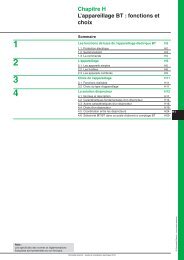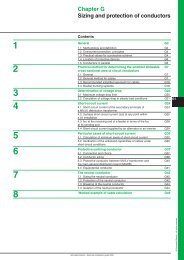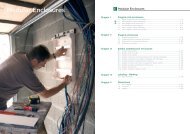Electrical Installation Guide 2009 - the global specialist in energy ...
Electrical Installation Guide 2009 - the global specialist in energy ...
Electrical Installation Guide 2009 - the global specialist in energy ...
- No tags were found...
Create successful ePaper yourself
Turn your PDF publications into a flip-book with our unique Google optimized e-Paper software.
B - Connection to <strong>the</strong> MV publicdistribution network3 Protection aspectTimeDCABM<strong>in</strong>imum pre-arc<strong>in</strong>gtime of MV fuseB/A u 1.35 at anymoment <strong>in</strong> timeD/C u 2 at anycurrent valueCircuit breakertripp<strong>in</strong>gcharacteristicCurrentFig. B18 : Discrim<strong>in</strong>ation between MV fuse operation and LVcircuit-breaker tripp<strong>in</strong>g, for transformer protectionU 1 MV LV U 2Fig. B19 : MV fuse and LV circuit-breaker configurationb In order to achieve discrim<strong>in</strong>ation:All parts of <strong>the</strong> fuse or MV circuit-breaker curve must be above and to <strong>the</strong> right of <strong>the</strong>CB curve.b In order to leave <strong>the</strong> fuses unaffected (i.e. undamaged):All parts of <strong>the</strong> m<strong>in</strong>imum pre-arc<strong>in</strong>g fuse curve must be located to <strong>the</strong> right of <strong>the</strong> CBcurve by a factor of 1.35 or more (e.g. where, at time T, <strong>the</strong> CB curve passes througha po<strong>in</strong>t correspond<strong>in</strong>g to 100 A, <strong>the</strong> fuse curve at <strong>the</strong> same time T must pass througha po<strong>in</strong>t correspond<strong>in</strong>g to 135 A, or more, and so on...) and, all parts of <strong>the</strong> fuse curvemust be above <strong>the</strong> CB curve by a factor of 2 or more (e.g. where, at a current level I<strong>the</strong> CB curve passes through a po<strong>in</strong>t correspond<strong>in</strong>g to 1.5 seconds, <strong>the</strong> fuse curveat <strong>the</strong> same current level I must pass through a po<strong>in</strong>t correspond<strong>in</strong>g to 3 seconds, ormore, etc.).The factors 1.35 and 2 are based on standard maximum manufactur<strong>in</strong>g tolerancesfor MV fuses and LV circuit-breakers.In order to compare <strong>the</strong> two curves, <strong>the</strong> MV currents must be converted to <strong>the</strong>equivalent LV currents, or vice-versa.Where a LV fuse-switch is used, similar separation of <strong>the</strong> characteristic curves of <strong>the</strong>MV and LV fuses must be respected.b In order to leave <strong>the</strong> MV circuit-breaker protection untripped:All parts of <strong>the</strong> m<strong>in</strong>imum pre-arc<strong>in</strong>g fuse curve must be located to <strong>the</strong> right of <strong>the</strong>CB curve by a factor of 1.35 or more (e.g. where, at time T, <strong>the</strong> LV CB curve passesthrough a po<strong>in</strong>t correspond<strong>in</strong>g to 100 A, <strong>the</strong> MV CB curve at <strong>the</strong> same time T mustpass through a po<strong>in</strong>t correspond<strong>in</strong>g to 135 A, or more, and so on...) and, all parts of<strong>the</strong> MV CB curve must be above <strong>the</strong> LV CB curve (time of LV CB curve must be lessor equal than MV CB curves m<strong>in</strong>us 0.3 s)The factors 1.35 and 0.3 s are based on standard maximum manufactur<strong>in</strong>gtolerances for MV current transformers, MV protection relay and LV circuit-breakers.In order to compare <strong>the</strong> two curves, <strong>the</strong> MV currents must be converted to <strong>the</strong>equivalent LV currents, or vice-versa.B19Choice of protective device on <strong>the</strong> primary side of <strong>the</strong>transformerAs expla<strong>in</strong>ed before, for low reference current, <strong>the</strong> protection may be by fuses or bycircuit-breaker.When <strong>the</strong> reference current is high, <strong>the</strong> protection will be achieved by circuit-breaker.Protection by circuit-breaker provides a more sensitive transformer protectioncompared with fuses. The implementation of additional protections (earth faultprotection, <strong>the</strong>rmal overload protection) is easier with circuit-breakers.3.3 Interlocks and conditioned operationsMechanical and electrical <strong>in</strong>terlocks are <strong>in</strong>cluded on mechanisms and <strong>in</strong> <strong>the</strong> controlcircuits of apparatus <strong>in</strong>stalled <strong>in</strong> substations, as a measure of protection aga<strong>in</strong>st an<strong>in</strong>correct sequence of manœuvres by operat<strong>in</strong>g personnel.Mechanical protection between functions located on separate equipment(e.g. switchboard and transformer) is provided by key-transfer <strong>in</strong>terlock<strong>in</strong>g.An <strong>in</strong>terlock<strong>in</strong>g scheme is <strong>in</strong>tended to prevent any abnormal operational manœuvre.Some of such operations would expose operat<strong>in</strong>g personnel to danger, some o<strong>the</strong>rswould only lead to an electrical <strong>in</strong>cident.Basic <strong>in</strong>terlock<strong>in</strong>gBasic <strong>in</strong>terlock<strong>in</strong>g functions can be <strong>in</strong>troduced <strong>in</strong> one given functionnal unit; someof <strong>the</strong>se functions are made mandatory by <strong>the</strong> IEC 62271‐200, for metal-enclosedMV switchgear, but some o<strong>the</strong>rs are <strong>the</strong> result of a choice from <strong>the</strong> user.Consider<strong>in</strong>g access to a MV panel, it requires a certa<strong>in</strong> number of operationswhich shall be carried out <strong>in</strong> a pre-determ<strong>in</strong>ed order. It is necessary to carry outoperations <strong>in</strong> <strong>the</strong> reverse order to restore <strong>the</strong> system to its former condition. Ei<strong>the</strong>rproper procedures, or dedicated <strong>in</strong>terlocks, can ensure that <strong>the</strong> required operationsare performed <strong>in</strong> <strong>the</strong> right sequence. Then such accessible compartment will beclassified as “accessible and <strong>in</strong>terlocked” or “accessible by procedure”. Even forusers with proper rigorous procedures, use of <strong>in</strong>terlocks can provide a fur<strong>the</strong>r helpfor safety of <strong>the</strong> operators.© Schneider Electric - all rights reservedSchneider Electric - <strong>Electrical</strong> <strong>in</strong>stallation guide <strong>2009</strong>
















